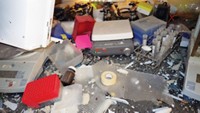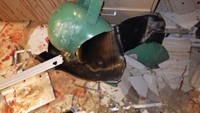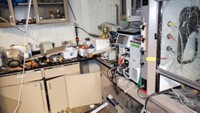Advertisement
Grab your lab coat. Let's get started
Welcome!
Welcome!
Create an account below to get 6 C&EN articles per month, receive newsletters and more - all free.
It seems this is your first time logging in online. Please enter the following information to continue.
As an ACS member you automatically get access to this site. All we need is few more details to create your reading experience.
Not you? Sign in with a different account.
Not you? Sign in with a different account.
ERROR 1
ERROR 1
ERROR 2
ERROR 2
ERROR 2
ERROR 2
ERROR 2
Password and Confirm password must match.
If you have an ACS member number, please enter it here so we can link this account to your membership. (optional)
ERROR 2
ACS values your privacy. By submitting your information, you are gaining access to C&EN and subscribing to our weekly newsletter. We use the information you provide to make your reading experience better, and we will never sell your data to third party members.
Lab Safety
Spark from pressure gauge caused University of Hawaii explosion, fire department says
Postdoc Thea Ekins-Coward, who lost an arm in the incident, was using a gauge not specified for work with flammable gases
by Jyllian Kemsley
April 19, 2016
An explosion last month that caused a University of Hawaii, Manoa, postdoctoral researcher to lose an arm was caused by a spark from a digital pressure gauge that was not designed for use with flammable gases, says a Honolulu Fire Department investigation report.

Thea Ekins-Coward was combining hydrogen, carbon dioxide, and oxygen gases from high-pressure cylinders into a lower pressure tank when the incident occurred. She has not given the university permission to release information about her condition, said spokesman Daniel Meisenzahl at an April 18 press conference.
The gas mixture was “food” for bacteria being used to produce biofuels and bioplastics. Ekins-Coward was working for the Hawaii Natural Energy Institute under researcher Jian Yu. A 2013 paper by Yu indicates a set-up in which gases are plumbed through a mixing device called a gas proportioner directly into the bioreactor (Int. J. Hydrogen Energy 2013, DOI: 10.1016/j.ijhydene.2013.04.153). The gas gauge identified in the paper is an “intrinsically safe” model designed to prevent ignition.
But after Ekins-Coward started in the lab last fall, she purchased a 49-L steel gas tank, a different gauge not rated as intrinsically safe, a pressure-relief valve, and fittings, and she put them together, Yu and Ekins-Coward told fire department investigators, according to the report. Ekins-Coward would add the gases to the portable tank, which would then be connected to the bioreactor. She was using a mixture of 70% hydrogen, 25% oxygen, and 5% carbon dioxide for her experiments, the report says.
In the week before the incident, a similar set-up with a 3.8-L tank resulted in a “small internal explosion” when Ekins-Coward pressed the off button on the gauge, the fire department report says. She also occasionally experienced static shocks when touching the tank, which was not grounded. She reported the shocks and possibly the small explosion to Yu, who told her not to worry about it, the report says.
On the day of the incident, the 49-L tank exploded when Ekins-Coward pressed the off button on the gauge. “She did not lose consciousness or hit her head; she was aware that she lost her arm in the explosion,” the report says. “She couldn’t open the door to the lab, the door was stuck closed.” Security officers and a graduate student kicked in the door to help Ekins-Coward get out. Her right arm was severed just above the elbow, the report says.
The University of Hawaii hired the University of California Center for Laboratory Safety to independently investigate the incident. That report is expected to be completed by the end of this month. The Hawaii Occupational Safety & Health Division is also investigating the incident.
Disaster Scene
These photos, released by the Honolulu Fire Department,
llustrate the force of the March 16 explosion and its consequences.
(warning: some images are graphic)


















Join the conversation
Contact the reporter
Submit a Letter to the Editor for publication
Engage with us on Twitter